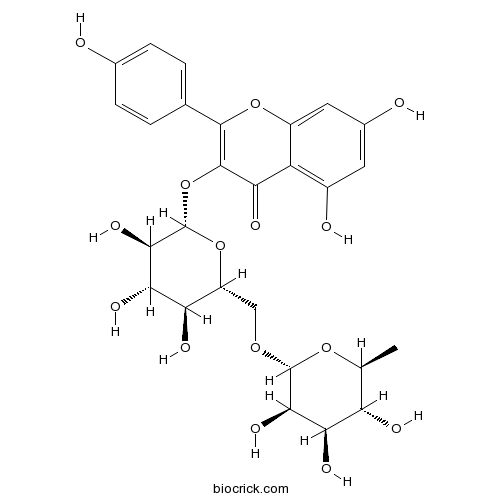A kaempferol O-glucoside that is kaempferol attached to a rutinosyl [6-deoxy-α-L-mannosyl-(1→6)-β-D-glucosyl] residue at position 3 via a glycosidic linkage. It has been isolated from the leaves of Solanum campaniforme.
InChI=1S/C27H30O15/c1-9-17(31)20(34)22(36)26(39-9)38-8-15-18(32)21(35)23(37)27(41-15)42-25-19(33)16-13(30)6-12(29)7-14(16)40-24(25)10-2-4-11(28)5-3-10/h2-7,9,15,17-18,20-23,26-32,34-37H,8H2,1H3/t9-,15+,17-,18+,20+,21-,22+,23+,26+,27-/m0/s1
Nicotiflorin is a flavonoid glycoside extracted from a traditional Chinese medicine Flos Carthami, it has a protective effect against cerebral ischemic damage.[1]
Nicotiflorin has protective effects on reducing memory dysfunction, energy metabolism failure and oxidative stress in multi-infarct dementia model rats.[2]
Nicotiflorin has neuroprotection in permanent focal cerebral ischemia and in neuronal cultures. [3]
English website: Nicotiflorin
Japanese website: Nicotiflorin
Chinese website: Nicotiflorin
[1] Li R, Guo M, Zhang G, et al. J Ethnopharmacol, 2006, 107(1):143-50.
[2] Huang J, Fu S Y, Cao Y, et al. Pharmacol Biochem Behavior, 2007, 86(4):741-8.
[3] Li R, Guo M, Zhang G, et al. Biol Pharm Bull, 2006, 29(9):1868-72.
[4] Sun J, Xiao-Juan H E, Liu J Q. China Pharmacy, 2015, 9.



